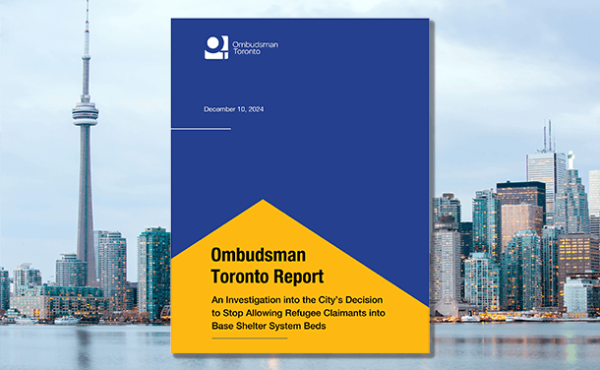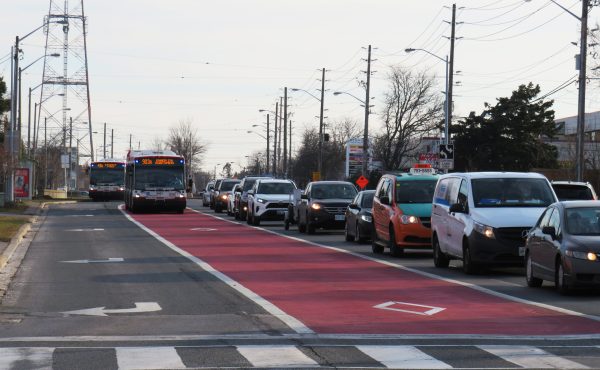
For my next party trick, I’m going to solve the stand-off between the Stintz/DeBaeremaeker One City faction and the Ontario Liberals in three easy steps:
One, the McGuinty government passes a law — let’s call it the Greater Toronto Council Act (2012) — establishing a regional body, which is made up of politicians appointed from their GTA municipal councils and includes a chair elected by the members of this group, plus an executive committee comprised of the mayors (or designates) of the region’s five most populous cities.
Two, the province gives this new GTA council a formal mandate to (i) implement the regional planning goals of the GTA portion of the Places to Grow Act (2005); and (ii) approve the infrastructure investment recommendations of Metrolinx, which will answer to this body instead of a provincial ministry.
Three, Queen’s Park passes legislation allowing this GTA council (shall we call it One City?) the power to levy two classes of revenues: first, a regional property tax levy sufficient to cover administrative and planning costs; second, a menu of other revenue tools that must be dedicated to the construction of new transit infrastructure across the region.
This, of course, is not my party trick. Seventeen years ago, Anne Golden led a taskforce that recommended the creation of a democratically-accountable GTA council tasked to deal with various regional problems. Very high on her list of said problems was transportation. Mike Harris’s Tories ignored her, and so have Dalton McGuinty’s Liberals, who diligently pursued a passive-aggressive approach to growth management in the GTA. (Note to web archivists and urban policy nerds: Golden’s 1996 GTA Taskforce report is not online — and should be!)
Which brings me back to last Friday’s perplexing head-on collision between a provincial regime that needs to raise one heck of a lot of money to build transit and a municipal council offering up its own constituents to do precisely that. Go figure.
With the winds of public opinion at their backs, Stintz et al have vowed to press on in the face of transportation minister Bob Chiarelli’s knee-jerk objections.
The question is, how to proceed?
I’d say both sides in this complicated mating dance need to think about short, medium- and long-term solutions to the two solitudes crisis that lies at the heart of the structural disconnect between the City of Toronto and Metrolinx.
Short Term: Council, by itself, should move swiftly (i.e., in this budget cycle) to approve a dedicated, time-limited levy to raise the $200 million needed to build the waterfront LRT line to the newly developing waterfront areas (West Donlands, East Bayfront and the Portlands). This tax hike can be packaged as a city-building move that will not only attract development but also, in a conciliatory gesture towards the province, help Infrastructure Ontario recoup its substantial investment in the West Donlands properties being developed for the 2015 Pan Am Games.
Such a move is a no-brainer. Everyone save Mayor Gypsy Moth and his taxophobic brother agree that rapid transit to these new waterfront communities is indispensible. Further, the cost only rises over time. Suck it up and get the thing built by 2015 so the city doesn’t look foolish in the eyes of the world (doubters should just imagine the inevitable shuttle bus disaster stories in the international media). Waiting means wasting taxpayer money in the future. Simple as that.
Medium Term: The city, the inner-ring 905 municipalities, Metrolinx and the province must set up a working group now to take stock of both the Big Move and One City, with the goal of figuring out whether and how new proposals such as the Scarborough subway extension can be incorporated. (Josh Matlow has moved a motion that would see council ask Metrolinx, the 905 municipalities and the province set up a working group to talk about the elusive investment strategy.)
Metrolinx, in fact, is undertaking a highly controlled mini-review of the Big Move this year, and there’s a formal review required in 2013 under the terms of the Metrolinx legislation.
My question: why wait? By any objective standard, it makes far more sense for the parties to have an updated, consensus-based plan to sell to the public before we all start bickering and bitching about the money required to build it.
Stintz told me Friday that Metrolinx and the minister’s office have long been resistant to such suggestions. To give Metrolinx its due, I understand the agency’s reluctance to tinker. It has an enormous technical job on its hands, and there are large projects underway that can’t simply be turned on and off at whim.
Exhibit A: the Air-Rail Link. The One City group, in my view, made a tactical error in demanding that the province to transform this premium service into a local express train. Time will tell whether there’s sufficient ridership to justify the premium price for an ARL ticket; if there isn’t, Metrolinx will have to come up with a Plan B to recoup sunk costs, which will likely be an affordable localized service.
So if council truly wants to cut deals with the province/Metrolinx, it has to look for opportunities to engage that aren’t unduly provocative. By the same token, the province has to not only recognize the legitimacy of the political feedback it receives from the city, but also find meaningful ways of incorporating said views into its planning processes. Sorry, but narrow legislative reviews don’t cut it.
Metrolinx’s default mode is to defend GO — that’s very clear. But GO, the City of Toronto and the 905 have a symbiotic relationship: those tens of thousands of suburban commuters fill the downtown skyscrapers, which, in turn, produce vast troves of commercial property tax revenue for the City and equally vast troves of residential assessment for the 905. Metrolinx’s governance, planning and policy development processes must reflect this interwoven urban/suburban reality. Yet at the highest level — and notwithstanding the efforts of their respective staffs to collaborate operationally — Metrolinx and the City remain two solitudes.
Want proof? When a provincial cabinet minister gets the nod from the premier’s office to rain negativity down on the heads of two ideologically friendly TTC commissioners who, in all likelihood, have the votes to create a council process and a helpful funding decision, it is prima facie evidence of a political disconnect.
Long Term: As it looks ahead to decades of transit infrastructure expansion and all the planning changes needed to make those investments pay dividends, the Liberals must come to grips with the fact that the governance process they have set up for, and around, Metrolinx since 2005 is fatally flawed. At heart, it’s a tenacious structural problem born of the Harris regime’s governance moves.
How else to account for the strange fact that Metrolinx, without a single elected official on its board, has quietly inserted itself into land-use planning through its “mobility hub” process? Yes, there’s a certain bureaucratic logic behind Metrolinx’s attempts to rethink the future of GO’s suburban parking lots. Still, if ever there was an example of mission creep, this one fits the bill perfectly. Last I checked, municipalities in Ontario do land use planning, not provincial operating agencies.
Coming back to One City, the leadership on Toronto council could and should enjoin the 905 municipalities to put pressure on Queen’s Park to confront the region’s governance deficit as a pre-condition for the investment strategy, and the long slog of transportation reform that awaits this region in the next 30 years.
After all, their constituents will also be paying these various levies and, one would hope, helping to guide the land use decisions that accompany the related transit investments. It only is reasonable that they/we have a democratic forum in which to express their/our goals and concerns, and to hold the decision-makers accountable.
Needless to say, Ontario’s ministry of transportation is not that forum.
photo by Wylie Poon





4 comments
The One City plan isn’t perfect but at least it’s sparked a discussion about how to pay for transit. The twitter discussion between Josh Matlow and the Mayor of Oakville was enlightening and I imagine it was representative of the many private meetings that have been happening.
It’s a great step forward except for the fact that the Province has put its fingers in its ears and refuses to have any sort of discussion. There are plenty of good ideas out there and the McGuinty crew seems glad to ignore every one of them.
Not to mention our increasingly irrelevant mayor.
It seems clear to me that the OneCity plan while good on paper has little chance of getting support from the cash strapped province. It is unlikely that Queens park would agree to billions in spending while delaying transportation projects across the province.
A GTA Council is a great idea. The lack of regional collaboration is hurting everyone. Should be looking at coordinating economic development and transportation across the entire region.
Residential assessment growth, certainly in Toronto and usually in the 905, entails growth in expenditures that exceed the new tax revnue. Besides the notion that Toronto (GTA) fits the old Hamiltonian model of a monocentric city is absurd. The city proper has less people working full time within its borders than twenty years ago. A look at the census usual place of work data shows that the trend of reverse commuting is rapidly growing. Mississauga, York Region and Markham are net importers of labour from Toronto. Despite the facts, there is a misguided notion that building public transit within the city, when its citiznes are increasingly commuting outside of it, is going to cure it of its congestion problems.
I have been trying to find the total capital costs for the Georgetown South Project and the Air Rail Link but I could only find them for 2011/12 and 2012/13. I tried searching the MetroLinx website but they are champions at storing information under useless labels. I clicked on one that looked promising and the text was in what looked like a cross between Vulgate Latin and Spanish so I gave up.
The costs that I have in millions of dollars are:
2011/12 2012/13 Total
ARL 25 77 102
GTS 266 235 401
total 291 312 503
GTS – Georgetown South Project
For this half billion dollar expense what does the GO rider get? Not a whole lot before 2018 according to rumour. They might save 5 to 10 minutes off the trip time but they could have probably done most of that by getting rid of the construction. There will be no 15 minute rush hour service, no 30 minute peak counter flow service, no off peak service. There might be another train or two in the peak.
Most of the $400 million being charged to GO should really be charged to the ARL because without it ARL could not happen. GO could probably run at the planned frequencies with very little being spent. SO Benny, we are spending $500 million over two years, (I can’t find the expenses before 2011/12) so you fat cat Lawyer can get to Europe or Asia faster while the regular GO passengers have to put up with second class service. Common Cynthia, tell Dalton to smarten up.